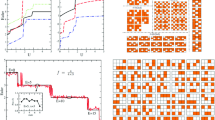Abstract
We discuss the interrelation between phase transitions in interacting lattice or continuum models, and the existence of infinite clusters in suitable random-graph models. In particular, we describe a random-geometric approach to the phase transition in the continuum Ising model of two species of particles with soft or hard interspecies repulsion. We comment also on the related area-interaction process and on perfect simulation.
Access this chapter
Tax calculation will be finalised at checkout
Purchases are for personal use only
Preview
Unable to display preview. Download preview PDF.
Similar content being viewed by others
References
Baddeley, A.J., M.N.M. van Lieshout (1995): ‘Area-interaction point processes’, Ann. Inst. Statist. Math. 46, pp. 601–619
Chayes, J.T., L. Chayes, R. Kotecký (1995): ‘The analysis of the Widom-Rowlinson model by stochastic geometric methods’, Commun. Math. Phys. 172, pp. 551–569
Edwards, R.G., A.D. Sokal (1988): ‘Generalization of the Fortuin-Kasteleyn—Swendsen-Wang representation and Monte Carlo algorithm’, Phys. Rev. D 38, pp. 2009–2012
Fortuin, C.M., P.W. Kasteleyn (1972): ‘On the random-cluster model. I. Introduction and relation to other models’, Physica 57, pp. 536–564
Georgii, H.-O. (1988): Gibbs Measures and Phase Transitions (de Gruyter, Berlin New York)
Georgii, H.-O. (1994): ‘Large Deviations and the Equivalence of Ensembles for Gibbsian Particle Systems with Superstable Interaction’, Probab. Th. Rel. Fields 99, pp. 171–195
Georgii, H.-O. (1995): ‘The Equivalence of Ensembles for Classical Systems of Particles’, J. Statist. Phys. 80, pp. 1341–1378
Georgii, H.-O. (1999): ‘Translation invariance and continuous symmetries in two dimensional continuum systems’. In: Mathematical results in Statistical Mechanics, ed. by S. Miracle-Sole, J. Ruiz, V. Zagrebnov (World Scientific, Singapore etc.), pp. 53–69
Georgii, H.-O., O. Häggström (1996): ‘Phase transition in continuum Potts models’, Commun. Math. Phys. 181, pp. 507–528
Georgii, H.-O., O. Häggström, C. Maes (1999): ‘The random geometry of equilibrium phases’. In: Critical phenomena, ed. by Domb and J.L. Lebowitz (Academic Press), forthcoming
Georgii, H.-O., Y. Higuchi (1999): ‘Percolation and number of phases in the 2D Ising model’, submitted to J. Math. Phys.
Georgii, H.-O., T. Küneth (1997): ‘Stochastic comparison of point random fields’, J. Appl. Probab. 34, pp. 868–881
Grimmett, G.R. (1999): Percolation, 2nd ed. (Springer, New York)
Gruber, Ch., R.B. Griffiths (1986): ‘Phase transition in a ferromagnetic fluid’, Physica A 138, pp. 220–230
Häggström, O., M.N.M. van Lieshout, J. Moller (1997): ‘Characterization results and Markov chain Monte Carlo algorithms including exact simulation for some spatial point processes’, Bernoulli, to appear
Likos, C.N, K.R. Mecke, H. Wagner (1995): ‘Statistical morphology of random interfaces in microemulsions’, J. Chem. Phys. 102, pp. 9350–9361
Mecke, K.R. (1996): ‘A morphological model for complex fluids’, J. Phys.: Condens. Matter 8, pp. 9663–9668
Meester, R., R. Roy (1996): Continuum Percolation (Cambridge University Press)
Penrose, M.D. (1991): ‘On a continuum percolation model’, Adv. Appl. Probab. 23, pp. 536–556
Swendsen, R.H., J.-S. Wang (1987): ‘Nonuniversal critical dynamics in Monte Carlo simulations’, Phys. Rev. Lett. 58, pp. 86–88
Thönnes, E. (1999): ‘Perfect simulation of some point processes for the impatient user’, Adv. Appl. Probab. 31, pp. 69–87
Widom, B., J.S. Rowlinson (1970): ‘New model for the study of liquid-vapor phase transition’, J. Chem. Phys. 52, pp. 1670–1684
Author information
Authors and Affiliations
Editor information
Editors and Affiliations
Rights and permissions
Copyright information
© 2000 Springer-Verlag Berlin Heidelberg
About this paper
Cite this paper
Georgii, HO. (2000). Phase Transition and Percolation in Gibbsian Particle Models. In: Mecke, K.R., Stoyan, D. (eds) Statistical Physics and Spatial Statistics. Lecture Notes in Physics, vol 554. Springer, Berlin, Heidelberg. https://doi.org/10.1007/3-540-45043-2_10
Download citation
DOI: https://doi.org/10.1007/3-540-45043-2_10
Published:
Publisher Name: Springer, Berlin, Heidelberg
Print ISBN: 978-3-540-67750-5
Online ISBN: 978-3-540-45043-6
eBook Packages: Springer Book Archive




